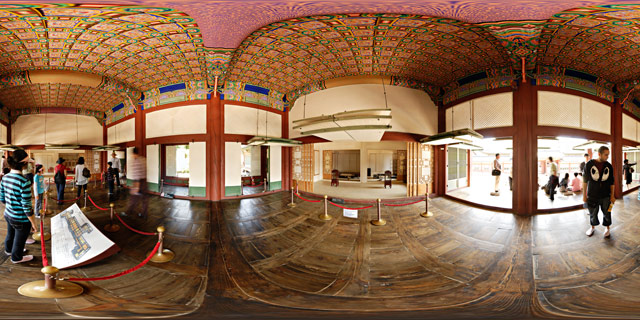
Gyotaejeon Hall interior 360 VR

Click button below to view 360° VR interactive panorama
SD Standard definition suitable for users with slow internet connections or mobile devices or HD High definition suitable for users with fast internet connections
360° VR panorama inside Gyotaejeon Hall in Gyeongbokgung Palace, Seoul, South Korea.
From Wikipedia:
Gyeongbokgung, also known as Gyeongbokgung Palace or Gyeongbok Palace, is a royal palace located in northern Seoul, South Korea. First constructed in 1394 and reconstructed in 1867, it was the main and largest palace of the Five Grand Palaces built by the Joseon Dynasty. The name of the palace, Gyeongbokgung, translates in English as “Palace Greatly Blessed by Heaven.”
Heavily destroyed by the Japanese government in the early 20th century, the palace complex is slowly being restored to its original form prior the destruction. As of 2009, roughly 40 percent of the original number of palace buildings still stand or are being reconstructed.
Gyotaejeon (Hangul: 교태전; Hanja: 交泰殿), also called Gyotaejeon Hall, is a building used as the main sleeping and living quarters by the queen during the Joseon Dynasty. The building is located behind Gangnyeongjeon, the king’s sleeping quarters, and contains the queen’s bed chamber. It was first constructed in around 1440, the 22nd year of King Sejong the Great.
King Sejong, who was noted to have a frail health later in his reign, decided to carry out his executive duties in Gangnyeongjeon, where his bed chamber is located, instead of Sajeongjeon. Since this decision meant many government officials routinely needed to visit and intrude Gangnyeongjeon, King Sejong had Gyotaejeon built in consideration of his wife the queen’s privacy.
The building was burned down in 1592 when the Japanese invaded Korea, but was reconstructed in 1867. Nevertheless, when Daejojeon of Changdeokgung Palace was burned down by a fire in 1917, the Japanese government dissembled the building and recycled its construction materials to restore Daejojeon. The current building was reconstructed in 1994 according to its original design and specifications. The building, like Gangnyeongjeon, does not have a top roof ridge called yongmaru.




